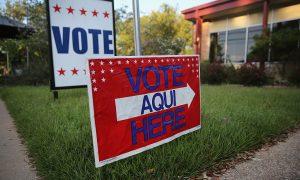The number of Hispanic voters increased by 11 million from 2000 to 2020.
The number of Hispanic voters participating in national and local elections is projected to increase significantly in 2024.
In a Feb. 14 presentation, NALEO Educational Fund CEO Arturo Vargas said more than 17.5 million Hispanic voters are likely to participate in November’s elections. That’s a 6.5 percent increase from 2020 and a 38.3 percent increase from 2016.
The largest increases, Mr. Vargas said, will be seen in Nevada, which is projected to experience a 15.5 percent increase from 2020; Florida, with 13.8 percent, and New York, with 12.4 percent, according to NALEO Education Fund data.
The organization projected the increase in Hispanic turnout will far exceed the 1.5 percent uptick it expects in overall voting.
According to NALEO statistics dating back to 2000, Hispanic participation steadily grows in every general election year. In 2000, about 5.9 million Hispanic voters cast ballots.
NALEO Education Fund identifies itself as a non-partisan, non-profit organization that “facilitates the full participation of Latinos in the American political process.”
Like most voters, Mr. Vargas said, Hispanic Americans have reported that the economy is their top political issue. With a number of competitive races along with the presidential race headed to the ballot in November, he expects both parties will work hard to court the voting bloc.
“Many of those districts will have a Latino electorate that will be decisive in the outcome,” Mr. Vargas said.
Mr. Vargas went on to say that NALEO data suggests that as many as 88 percent of Hispanic citizens who are registered to vote actually cast ballots. Both parties will be interested in registering those active voters.
Swing States
Swing states that are likely to be crucial to the outcome of national races, like the presidential election, are also expected to see notable increases.
Arizona, which President Joe Biden carried in 2020 after years of consistent Republican victories, is forecasted to see a 5.1 percent increase with more than 855,000 Hispanic voters participating. That’s a 57.5 percent increase from the about 543,000 that voted in 2016.
The Grand Canyon State will assign 11 votes to the Electoral College in 2024.
Georgia, which also flipped for President Biden in 2020, is expected to see a 9.3 percent increase in Hispanic voters, bringing the total to more than 194,000. That’s a 20.8 percent increase from 2016.
The Peach State will assign 16 electoral votes in 2024.
Florida, which saw its electoral vote count rise yet again to 30, is an essential state to watch in every presidential election.
According to U.S. Census Bureau statistics published in July 2023, 27.1 percent of the more than 22.6 million people living in Florida identify as Hispanic. More than 2 million Hispanic Floridians are forecasted to vote in 2024. That’s a 31.2 percent increase from 2016.
According to the U.S. Census Bureau’s findings from its 2020 census, about 62 million, or 18.7 percent of the recorded 331.4 million Americans, were reported as Hispanic or Latino.
The Census Bureau also reported the Hispanic population of the U.S. grew by 23 percent from the 2010 to 2020 census.
Original News Source Link – Epoch Times
Running For Office? Conservative Campaign Consulting – Election Day Strategies!



